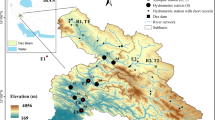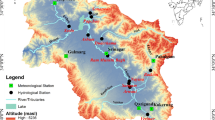Abstract
This paper examines trends in streamflow and their links with local climate in the Karkheh River and its major tributaries, which originate from the Zagros Mountains, Iran. Streamflow records from five mainstream stations for the period 1961–2001 were used to examine trends in a number of streamflow variables. The studied variables were mean annual and monthly flows, 1 and 7 days maximum and minimum flows, timing of the 1-day maxima and minima, and the number and duration of high and low flow pulses. Similarly, the precipitation and temperature data from seven climate stations for the period from 1950s to 2003 were used to examine trends in climatic variables and their correlation with the streamflow. The Spearman Rank test was used for the detection of trends and the correlation analysis was based on the Pearson method. The results reveal a number of significant trends in streamflow variables both increasing (e.g. December flows) and decreasing (e.g. May flows) for all stations. However, some trends were not spatially uniform. For example, decline in low flow characteristics were more significant in the upper parts of the basin, whereas increasing trends in floods and winter flows were noteworthy in the middle parts of the basin. Most of these trends could be attributed to precipitation changes. The results show that the decline in April and May precipitation causes the decline in the low flows while the increase in winter (particularly March) precipitation coupled with temperature changes lead to increase in the flood regime. The observed trends at the Jelogir station on the Karkheh River reflect the combined effect of the upstream catchments. The significant trends observed in a number of streamflow variables at Jelogir, 1-day maximum, December flow and low pulse count and duration, point to the changes in hydrological regime of the entire Karkheh River system and are attributed to the changes in climatic variables.
Similar content being viewed by others
References
Ahmad MD, Islam Md A, Masih I, Muthuwatta LP, Karimi P, Turral H (2009) Mapping basin-level water productivity using remote sensing and secondary data in the Karkheh River basin, Iran. Water Int 34(1):119–133
Alijani B (2002) Variations of 500 hPa flow patterns over Iran and surrounding areas and their relationship with the climate of Iran. Theor Appl Climatol 72:41–54
Alijani B, Ghohroudi M, Arabi N (2008) Developing a climate model for Iran using GIS. Theor Appl Climatol 92:103–112
Arnell NW (1999) The effect of climate change on hydrological regimes in Europe: a continental perspective. Glob Environ Change 9:5–33
Beniston M (2003) Climate change in mountain region: a review of possible impacts. Clim Change 59:5–31
Birsan MV, Molnar P, Burlando P, Pfaundler M (2005) Streamflow trends in Switzerland. J Hydrol 314:312–329
Bouraoui F, Grizzetti B, Granlund K, Rekolainen S, Bidoglio G (2004) Impact of climate change on the water cycle and nutrient losses in a Finish catchment. Clim Change 66:109–126
Burn DH, Elnur MAH (2002) Detection of hydrologic trends and variability. J Hydrol 255:107–122
Ceballos-Barbancho A, Morán-Tejeda E, Luengo-Ugidos MÁ, Llorente-Pinto JM (2008) Water resources and environmental change in a Mediterranean environment: the south west sector of the Duero river basin (Spain). J Hydrol 351:126–138
Cullen HM, Kaplan A, Arkin PA, Demenocal PB (2002) Impact of the north Atlantic oscillation on the Middle Eastern climate and streamflow. Clim Change 55:315–338
Demroes M, Kaviani M, Schaefer D (1998) An analysis of regional and intra-annual precipitation variability over Iran using multivariate statistical methods. Theor Appl Climatol 61:151–159
Dinpashoh Y, Fakheri-Fard A, Moghaddam M, Jahanbakhsh S, Mirnia M (2004) Selection of variables for the purpose of regionalization of Iran’s precipitation climate using multivariate methods. J Hydrol 297:109–123
Douglas EM, Vogel RM, Kroll CN (2000) Trends in floods and low flows in the United States: impact of spatial correlation. J Hydrol 240:90–105
Evans JP, Smith RB, Oglesby RJ (2004) Middle East climate simulation and dominant precipitation processes. Int J Climatol 24:1671–1694
Ficklin DL, Luo Y, Luedeling E, Zhang M (2009) Climate change sensitivity assessment of a highly agricultural watershed using SWAT. J Hydrol 374:16–29
George SS (2007) Streamflow in the Winnipeg River basin, Canada: trends, extremes and climate linkages. J Hydrol 332:396–411
Ghafouri M, Turkleboom F, Sarreshtehdhari A (2007) Integrated catchments management—lessons learned and Iranian vision. In: Ghafouri M (ed) Extended abstracts. International workshop on improving water productivity and livelihood resilience in Karkheh River Basin. Soil Conservation and Watershed Management Research Institutes (SCWNRI), Tehran, Iran, 10–11 September
Guo H, Hu Q, Jian T (2008) Annual and seasonal streamflow responses to climate and land-cover changes in the Poyang Lake basin, China. J Hydrol 355:106–122
Hargreaves GL, Hargreaves GH, Riley JP (1985) Agricultural benefits for Senegal River Basin. J Irrig Drain Eng 111:113–124
JAMAB (1999) Comprehensive assessment of national water resources: Karkheh River Basin. JAMAB Consulting Engineers in association with the Ministry of Energy, Iran (in Persian)
Lettenmaier DP, Wood EF, Wallis JR (1994) Hydro-climatological trends in the continental United States, 1948–88. J Climate 7:586–607
Mann ME (2002) Large-scale climate variability and connections with the Middle East in the past centuries. Clim Change 55:287–314
Masih I, Ahmad MD, Uhlenbrook S, Turral H, Karimi P (2009) Analysing streamflow variability and water allocation for sustainable management of water resources in the semi-arid Karkheh river basin, Iran. Phys Chem Earth 34(4–5):329–340
McCuen RH (2003) Modelling hydrologic change: statistical methods. Lewis, Boca Raton
Mirqasemi SA, Pauw EDe (2007) Land use change detection in KRB by using multi-temporal satellite images. In: Ghafouri M (ed) Extended abstracts. International workshop on improving water productivity and livelihood resilience in Karkheh river basin. Soil Conservation and Watershed Management Research Institutes (SCWNRI), Tehran, Iran, 10–11 September
Mitchell TD, Carter TR, Jones PD, Hulme M, New M (2004) A comprehensive set of high-resolution grids of monthly climate for Europe and the globe: the observed record (1901–2000) and 16 scenarios (2001–2100). Tyndall Centre, Working Paper 55
Modarres R, da Silva VdPR (2007) Rainfall trends in arid and semi-arid regions of Iran. J Arid Environ 70:344–355
Muthuwatta LP, Ahmad MD, Bos MG, Rientjes THM (2009) Assessment of water availability and consumption in the Karkheh River basin, Iran using remote sensing and geo-statistics. Water Resour Manag. doi:10.1007/s11269-009-9455-9
Nash LL, Gleick PH (1991) Sensitivity of streamflow in the Colorado basin to climatic changes. J Hydrol 125:221–241
Nazemosadat MJ, Cordery I (2000) On the relationships between ENSO and autumn rainfall in Iran. Int J Climatol 20:47–61
New M, Hulme M, Jones PD (2000) Representing twentieth century space-time climate variability Part 2. Development of 1901–1996 monthly grids of terrestrial surface climate. J Climate 13:2217–2238
Richter BD, Baumgartner JV, Wigington R, Braun DP (1997) How much water does a river need? Freshw Biol 37:231–249
Saghafian B, Davtalab R (2007) Mapping snow characteristics based on snow observation probability. Int J Climatol 27:1277–1286
Sutcliffe JV, Carpenter TG (1968) The assessment of runoff from a mountainous and semi-arid area in western Iran. In: Hydrological aspects of the utilization of water, IAHS general assembly of Bern, 383–394. IAHS Publication 76, IAHS Press, Wallingford, UK
Tizro AT, Voudouris KS, Eini M (2007) Groundwater balance, safe yield and recharge feasibility in a semi-arid environment: a case study from western part of Iran. J Appl Sci 20:2967–2976
Tu M (2006) Assessment of the effects of climate variability and land use change on the hydrology of the Meuse River Basin. PhD thesis, UNESCO-IHE Institute for Water Education, Delft/Vrije Universiteit, Amsterdam, The Netherlands, Taylor & Francis Group Plc, London, UK
von Storch H, Navarra A (eds) (1995) Analysis of climate variability: applications of statistical techniques. Springer, New York
Yue S, Wang CY (2002) Applicability of prewhitening to eliminate the influence of serial correlation on the Mann–Kendall test. Water Resour Res 38(6):1068. doi:10.1029/2001WR000861
Zangvil A, Karas S, Sasson A (2003) Connection between Eastern Mediterranean seasonal mean 500 hPa height and sea-level pressure patterns and the spatial rainfall distribution over Israel. Int J Climatol 23:1567–1573
Zhang X, Harvey KD, Hogg WD, Yuzyk TR (2001) Trends in Canadian streamflow. Water Resour Res 37:987–998
Author information
Authors and Affiliations
Corresponding author
Rights and permissions
About this article
Cite this article
Masih, I., Uhlenbrook, S., Maskey, S. et al. Streamflow trends and climate linkages in the Zagros Mountains, Iran. Climatic Change 104, 317–338 (2011). https://doi.org/10.1007/s10584-009-9793-x
Received:
Accepted:
Published:
Issue Date:
DOI: https://doi.org/10.1007/s10584-009-9793-x




